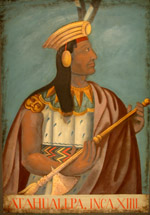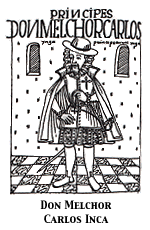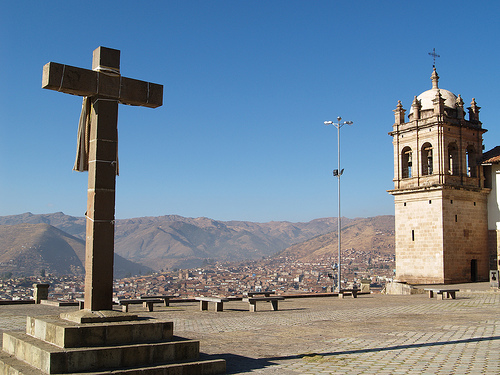The Last Days of the Incas’ Peru Tour #10 (Cusco)
posted on June 2nd, 2008 in Cuzco: Information about the former Inca capital, Incas, Peru, The Last Days of the Incas' Peru Tour
Cusco (3-4 Days)
Visiting The Cora Cora
To the north and uphill from the Plaza de Armas runs Suecia Street. At its base and reaching the plaza once stood the Cora Cora, which was the palace of Sinchi Roca, an early Inca king. During Manco Inca’s uprising, his warriors seized the area around Cora Cora, and from it rained down sling stones and arrows against the conquistadors, who were holed up next to what is now the Cathedral. Although the palace is not visible from the street, if you go into any of the courtyards or restaurants along Calle Suecia, you can still see one of the massive stone walls that made up the palace (have lunch in the Gaucho Grill, for example, whose massive rear wall is actually a 500-year-old palace wall).
Visiting the Church of Paullu Inca, Manco Inca’s Brother
If you continue up Suecia Street from the Cora Cora, then turn right and head up a parallel street further up the hill, called Resbalosa, you’ll come to San Cristóbal Church, which sits on a promontory that overlooks Cusco. The church was built by Paullu Inca, Atahualpa’s youngest brother and the brother of Manco Inca, the great Inca rebel emperor who fought a protracted war against the Spanish and nearly won…
When Manco was first crowned “emperor” by Francisco Pizarro in 1533, he and his brother Paullu were only 17 and 15 years of age, respectively. Paullu initially supported Manco and Manco in turn so trusted him that he soon sent Paullu with Diego de Almagro’s expedition to Chile in 1535. When Almagro returned two years later, however, and discovered that Manco had rebelled against the Spaniards, Paullu was faced with a stark choice: either of joining his brother in his guerrilla refuge east of the Andes or remaining in Cusco and becoming the new “puppet emperor” under the Spaniards instead. A political opportunist, Paullu quickly decided to abandon his brother and side with the Spaniards, an action that Manco never forgave him for. Even during the subsequent Spanish civil wars in Peru, Paullu remained politically adroit: he switched sides more than once yet always managed to somehow end up on the victorious side.
Although a royal Inca by birth, Paullu quickly embraced the Spaniards’ lifestyle, writing to the King of Spain to inform the King of his obedience and requesting various favors of him in return. The King rewarded his surrogate emperor well, granting him a number of large estates and ensuring that he was well taken care of.
Despite the fact that his oldest brother Atahualpa had been garroted by Francisco Pizarro and his other brother, Manco, continued his desperate struggle against the Spaniards, Paullu calmly walked about the streets of Cusco wearing imported Spanish clothing that included trendy European stockings and custom-tailored hats (see drawing at top: Atahualpa is on the left, Paullu is on the right). He also received instruction in the Catholic religion and was eventually baptized and given the Spanish name, Don Melchor Carlos Inca. With all the enthusiasm of a fresh convert, Paullu soon betrayed the Incas’ own religion by revealing the location of some of the mummies of his forefathers. This provoked outrage from native believers, who viewed the mummies as sacred. Spanish priests had the mummies burned.
Correctly deducing early on that the Spaniards would be victorious, Paullu lived long enough to learn that his brother Manco had been assassinated in his rebel capital of Vilcabamba in 1544. Paullu himself lived five years longer, dying peacefully in Cusco in 1549. Before he died, he had a Catholic church built overlooking Cusco, which he named “San Cristóbal,” in honor of his patron saint.
The church stills stands there today and you can climb into its belfry and get a grand view of the city that both he and his brother once ruled and fought over below.
(To be continued…)
(Below: San Cristóbal Church, Cusco)



